With an intense umami taste and irresistible crunch, Baby Sardine (Jako) Tsukudani makes the best companion to rice. It’s a classic and delicious Japanese preserved food of dried tiny sardines slowly simmered in a sweet-savory sauce to lock in the flavor.

At a typical Japanese meal, you can often find an alluring variety of small plates that offers a blast of flavor. These tasty sides include a simmered preserved dish known as Tsukudani. Intensely flavored, Tsukudani is very much like tsukemono (Japanese pickles). Both play an important role in complementing, contrasting, and accentuating a meal all at once.
Today, I will share the most classic Tsukudani recipe called Baby Sardine Tsukudani or jako no tsukudani (じゃこの佃煮).
Table of Contents
What is Tsukudani?
Tsukudani (佃煮) is a preserved food simmered in a salty-sweet sauce made of soy sauce, mirin, sake, and sugar. The liquid is cooked down until fully absorbed. This simple method locks in the flavor and conserves the nutritional value of the food naturally.
For Tsukudani, we typically use tiny fish (dried baby sardines), seaweed (kombu), or shellfish (asari or littleneck clams). Japanese families make large batches of seasoned kombu or seasoned dried sardines and freeze this side dish to eat over the course of the week.

History of Tsukudani in Japan
The name Tsukudani originates from Tsukudajima (佃島), the then island and now Chuo-ku in Tokyo. Before the Edo period, the fishermen of Tsukuda village helped the Tokugawa army escape their enemies. The brave fishermen fed the army preserved small fish, the earliest form of Tsukudani.
Originally, its preparation was simple. After some refinement, Tsukudani became a sought-after delicacy among elites in the Edo period (1603–1868) and slowly spread throughout the country. During the Meiji era (1868–1912), it was used as an emergency food and military ration. Tsukudani eventually became a big part of Japanese cooking and is still popular today.

What are Dried Baby Sardines (Chirimen Jako)?
Chirimen jako (ちりめんじゃこ) is the dried form of baby sardines called shirasu. Shirasu are a common seafood fare enjoyed in Japan and are rich in calcium, protein, and iron. We use them as a topping on Chilled Tofu (Hiyayakko) and Tamago Tofu, mixed into rice or rice balls, or as an ingredient in Furikake. You’ll find different names for shirasu based on how they are processed:
- nama shirasu (生しらす) – raw shirasu
- kamaage shirasu or kama-age shirasu (釜揚げしらす) – lightly boiled and soft
- shirasu-boshi (しらす干し) – boiled and lightly dried
- chirimen jako, chirimenjako, or jako (ちりめんじゃこ・じゃこ) – boiled and completely dried
I used chirimen jako in this recipe. These dried sardines just need a quick rinse to wash off the excess salt before cooking. In the US, you can find these dried immature fish in the refrigerated section of Japanese markets and some Asian grocery stores.

Ingredients You’ll Need
- chirimen jako (dried baby sardine)
- toasted white sesame seeds (optional)
- seasonings – soy sauce, mirin, sake, and sugar
How to Make Baby Sardine Tsukudani
Follow my step-by-step instructions and cooking tips in the recipe below. Here’s a quick overview:
- Quickly rinse the dried baby sardines under running water. Drain and transfer to a saucepan.
- Add the seasonings to the saucepan.
- Heat over medium heat.
- Boil, then simmer on low heat for 15 minutes. Once the sauce has thickened, it’s done!
Tsukudani keeps in the refrigerator for up to 3 weeks or the freezer for 2-3 months.

How to Enjoy Baby Sardine Tsukudani
With an intense umami flavor and an irresistible crunch, Baby Sardine Tsukudani is delicious scooped onto plain steamed rice! You can also enjoy delicious Tsukudani in other fun ways:
- in Ochazuke with tea poured over the Tsukudani and rice
- as a filling for Onigiri (rice balls)
- as a savory snack to enjoy with sake
- added to your bento box

Another Tsukudani Recipe You May Enjoy
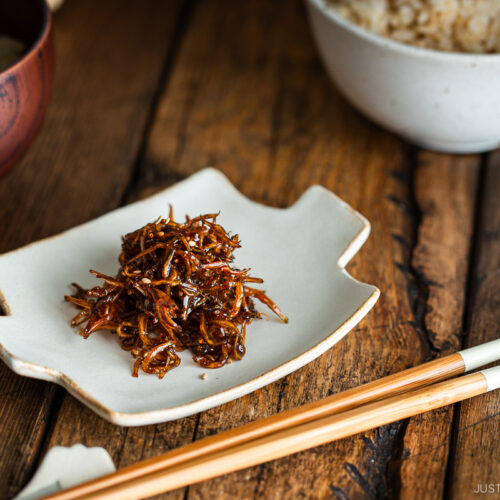
Baby Sardine Tsukudani
Ingredients
- 2.8 oz chirimen jako (dried baby sardine) (80 g)
- ½ Tbsp toasted white sesame seeds (optional)
Instructions
- Gather all the ingredients.

- Quickly rinse the dried baby sardines under running water. This helps to clean and to remove excess saltiness from the fish. Drain the baby sardines well and transfer them to the saucepan.
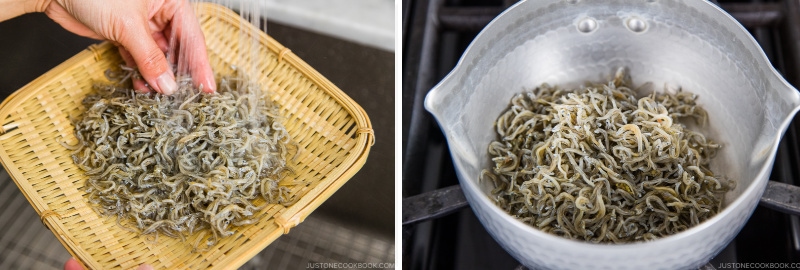
- Add mirin, sake, sugar, and soy sauce in the saucepan.

- Mix all the ingredients and turn the heat to medium heat.
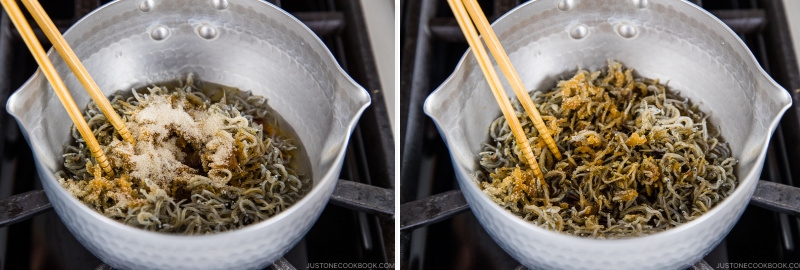
- Bring the sauce to boil. Once boiling, skim off the foam and reduce the heat to low.
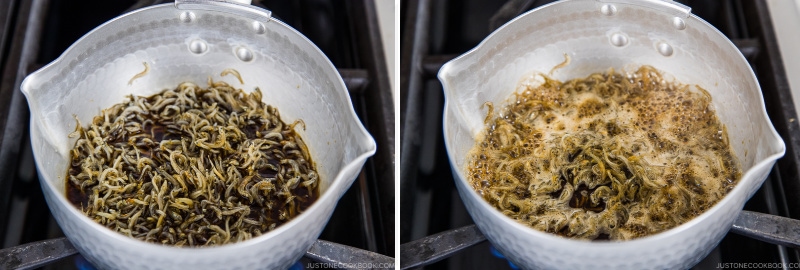
- Cover the baby sardines with an otoshibuta (drop lid) and simmer on low heat, stirring occasionally, for 15 minutes. Be careful not to burn.

- Once the sauce has thickened and you can see the bottom of the pot, turn off the heat. Transfer the Tsukudani to a glass container. Optionally, add the sesame seeds and mix well.

To Store
- You can keep the Tsukudani in the refrigerator for up to 3 weeks or the freezer for 2-3 months.
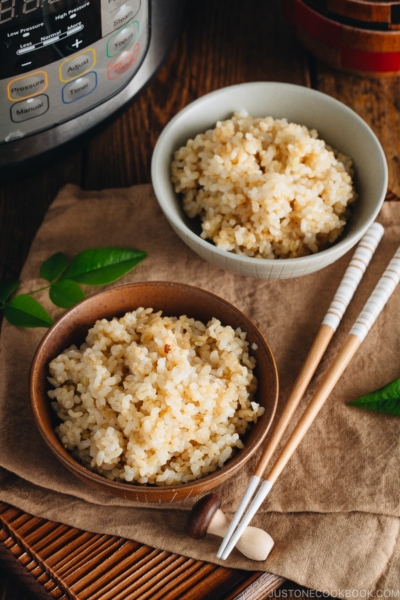


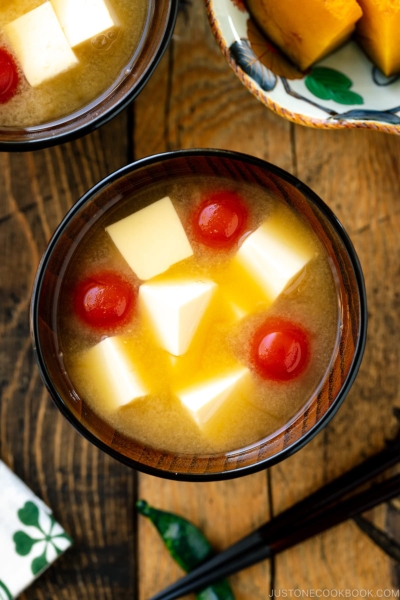





Hello! I had to order the dried baby sardines because they’re just not available anywhere around here. They arrived and I made this recipe. My old mother did not recognize this at first but then she tasted it and she made a big smile and remembered. Thank you! These were a tasty part of a good lunch today. I like this more than candied niboshi, but both are yummy.
Hello, Toshi! We are glad to hear you and your mother enjoyed this dish. 🤗
Thank you for trying Nami’s recipe and sharing your experiences with us. Happy cooking!
You don’t add oil? Cuz the ones I get to eat to in Japanese right restaurants seem oily.
Hi Chit, Thank you for reading Nami’s post!
In Japan, the Tsukudani is made with simple ingredients and usually doesn’t include oil.
It may appear oily due to caramelization. We hope this was useful!
If I use kamaage shirasu for this recipe, do I need to adjust the amount of salt or liquid?
Hi Mon! Thank you very much for trying Nami’s recipe!
The Kamaage Shirasu is very soft, and it’s moist. It would probably need only half of the seasonings in this recipe.
Please note that the texture would be very soft and different from this recipe.
We hope this helps!
Can you use fresh しらす for this recipe?
Hi Clement! You can use Shirasu to make this dish. 🙂
This is definitely a recipe I will make again in the future! Really adds a nice flavor to my bentos
Hi Azadeh! Thanks so much for your kind feedback! Glad to hear you enjoyed it! 🙂